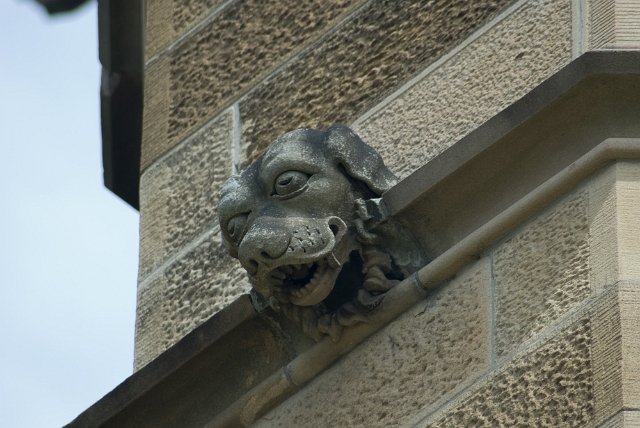
Quick, identify the object in the photo below!

If you said it was a gargoyle, you would be wrong.
The photo below, now that’s a gargoyle.

Though both appear to be similar in their depiction and situation, there is a difference.
The top photo taken by Rodhullandemu isn’t a gargoyle, but a “grotesque.” The half-dragon, half dog guards the clock tower of Liverpool Municipal Building.
The photo below that is of a gargoyle, and this one sits on the north-east side of St John’s Church in Hereford. The main difference between a gargoyle and a grotesque is in their function on a building. Gargoyles are essentially water spouts — a decorative but functional way to direct rainwater away from a building’s walls to save them from erosion. You can tell the difference because a gargoyle will most often have an opening somewhere on it it (usually its mouth) through which water can flow. In fact, the word, “gargoyle” comes from the Old French word, “gargouille,” meaning throat.
A grotesque, on the other hand, is a purely decorative sculpture with no functional purpose. While the subject, often a whimsical or mythical creature, can also have its mouth open, it isn’t to channel or spout water (if you’re not confused, try this: All gargoyles are grotesque in appearance, but not all grotesques are gargoyles). That said, grotesques did have a purpose, and that was to either ward off evil spirits and protect the building, or add visual interest to the structure.
Over time, the distinction between gargoyles and grotesques has become less strict, and many people use the terms interchangeably – but historians and architectural purists don’t, and we wanted you to know the difference, too. Why? So that when you see one on a building, you actually know what it is, and can dazzle others with your knowledge. And yes, there are dog gargoyles.
The Cathedral of Saint-Just and Saint-Pasteur in Narbonne, France features a charming Saint Bernard gargoyle. The dog’s more modern lifelike depiction and the lack of weathering compared to its surroundings supports the belief that the Saint was added during a 19th century restoration of the church.

Photo believed to have been taken by Anne Giovas via https://ascholarlyskater.com/
The Catholic cathedral in Worms, Germany has a famous Dachshund gargoyle which, according to legend, was added by Philipp Brandt, the cathedral’s master builder. As the story goes, the Dachshie was Brandt’s constant companion, even as he worked on the cathedral. One day while Brandt was working on a scaffold, the dog suddenly jumped on him and tried to bite his leg which caused Brandt to move – moments before a piece of rock fell where he had just been standing. Realizing the dog had saved his life, Brandt immortalized his faithful companion by adding its likeness to the cathedral’s south portal.
For more on this topic, check out “The Architectural Dog” written by Nick Waters for Dog News.
Image: The top photo is of a grotesque, a stock photos from http://creativity103.com licensed under a Creative Commons Attribution 3.0 License.
